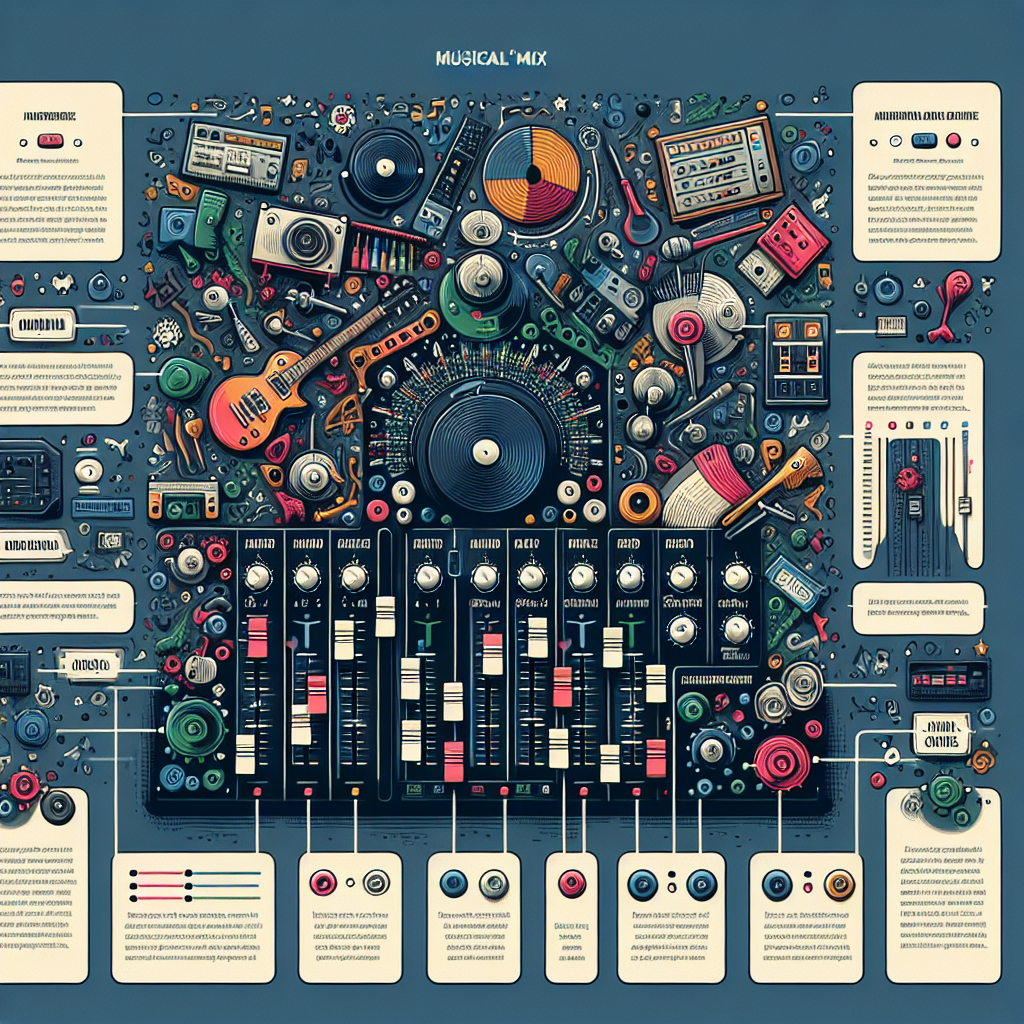
Have you ever wondered what the term “mix” means in the context of music? Simply put, a mix in music refers to the process of blending different elements together to create a harmonious and balanced sound. This involves adjusting the levels, panning, and adding effects to various instruments and vocals, resulting in a final version of a song that is ready to be enjoyed by listeners. In this article, we will explore the concept of mixing in music and unravel its importance in enhancing the overall quality and impact of a musical piece. So, get ready to uncover the secrets behind the art of mixing and its significance in the world of music.
What Does Mix Mean in Music
Understanding the Basics of Mixing
When it comes to music production, mixing is a crucial step in the process. It involves taking individual audio tracks and combining them together to create a cohesive and polished final product. Mixing is the art and science of balancing the different elements of a song, such as vocals, instruments, and effects, to achieve a pleasing and impactful sonic experience.
Artistic and Technical Aspects of a Mix
Mixing involves both artistic and technical aspects. On the artistic side, it requires translating the artist’s vision into the mix, capturing the emotions and intentions behind the music. A mix engineer needs to understand the genre and style of the song to make appropriate creative decisions.
On the technical side, mixing requires knowledge of various techniques and tools to achieve a balanced and professional sound. This includes using dynamics and compression to enhance or control the levels of different elements, applying effects for creativity and emphasis, and achieving cohesion and uniformity throughout the mix.

The Role of a Mixing Engineer
A mixing engineer plays a crucial role in the music production process. They are responsible for taking the raw materials of individual tracks and transforming them into a professional-sounding song. The mixing engineer uses their technical expertise and artistic sensibility to elevate the music and make it sound its best.
Collaboration is a key aspect of a mixing engineer’s role. They work closely with artists and producers, understanding their vision and goals for the music, and incorporating their feedback into the mix. Effective communication and decision-making skills are essential for a mixing engineer to successfully bring the artist’s vision to life.
Types of Mixes
There are various types of mixes depending on the specific needs and requirements of a project. A stereo mix is the most common type, where the audio is spread across two channels to create a sense of width and depth. On the other hand, a mono mix consolidates the audio into a single channel, often used for compatibility purposes.
Multi-track mixing involves working with individual tracks, allowing for more precise control over each element of the mix. Stem mixing, on the other hand, involves grouping related tracks together, such as drums or vocals, to simplify the mixing process and create a more manageable workflow.
There are also different versions of mixes, such as the final mix, which is the polished and completed version ready for distribution, and the rough mix, which is an early iteration to showcase the overall direction of the mix. Additionally, there are remixes and alternative mixes that provide different interpretations or variations of the original song.

Mixing Tools and Equipment
Mixing can be done in various environments, from professional recording studios to home studios. The primary tool used for mixing is a Digital Audio Workstation (DAW), which is software that allows for recording, editing, and processing audio. Popular DAWs include Pro Tools, Logic Pro, and Ableton Live.
In addition to the DAW, mixing engineers often use mixing consoles and controllers, which provide physical knobs and faders for hands-on control of the audio. This tactile experience enhances workflow and allows for precise adjustments. Plug-ins and software effects are also essential tools for mixing, providing a wide range of processing options to shape the sound.
Monitoring systems and studio acoustics are also important considerations in mixing. Accurate and reliable monitors, such as studio speakers or headphones, are necessary to hear the mix accurately. Additionally, ensuring proper acoustic treatment in the studio space helps to minimize unwanted reflections and create an optimal listening environment.
Common Techniques and Practices
Mixing involves a range of techniques and practices to achieve a professional sound. Gain staging and signal flow are fundamental concepts in mixing, ensuring that each track is at an appropriate volume level and maintaining a clean and clear signal path throughout the mix.
Equalization (EQ) and filters are used to shape the sound by selectively boosting or cutting specific frequencies. This allows for tonal balance and clarity in the mix. Dynamic processing, including compression and limiting, is used to control the dynamics of individual tracks and create a more consistent and polished sound.
Effects such as reverb and delay are used to create movement, ambience, and depth in the mix. These effects add space and dimension, enhancing the overall sonic experience. Automation is also a powerful technique used to make fine-tuning adjustments and create dynamic changes over time.
Step-by-Step Guide to Mixing a Song
Mixing a song involves a systematic approach to ensure all elements are properly balanced and processed. Here is a step-by-step guide to help you through the process:
-
Prepare and organize the session: Import the individual tracks into your DAW, label and color-code them for easy navigation, and set up any routing or bussing.
-
Set levels and ensure a clean signal: Adjust the volume levels of each track to achieve a balanced mix. Pay attention to clipping or distortion and make any necessary gain adjustments.
-
Balance the tracks and create a solid foundation: Start by establishing a solid rhythm section, such as drums and bass, and build the mix around it. Pay attention to the relative levels and ensure each element can be heard clearly.
-
Apply processing and effects to sculpt the mix: Use EQ to shape the tonal balance of each track, apply compression to control dynamics, and experiment with effects to add depth and character. Don’t be afraid to be creative and try different combinations to achieve the desired sound.
-
Make critical listening and adjustments: Take breaks and listen to the mix with fresh ears. Analyze the overall balance, clarity, and impact of the mix. Make any necessary adjustments to further enhance the sound.
-
Finalize the mix and prepare for mastering: Once you are satisfied with the mix, prepare it for mastering by ensuring proper fades, creating a final mixdown, and organizing the files for delivery.
Mixing for Different Genres
Different musical genres often have their own unique characteristics and mixing styles. Understanding these genre-specific styles is crucial in achieving the desired sound. For example, a pop mix may require a polished and upfront sound with emphasis on vocals and catchy hooks, while a rock mix may focus on a powerful and energetic sound with prominent guitars and drums.
Adapting mixing techniques for different genres involves understanding the sonic expectations of each style and tailoring the mix accordingly. This may include specific EQ choices, effects treatments, or overall tonal balance adjustments. Each genre presents its own set of challenges, and a skilled mixing engineer should be able to adapt and achieve the desired results.
The Impact of Mixing on the Final Product
The mixing stage has a significant impact on the final product of a song. A well-executed mix can elevate the music, bringing out the emotions and nuances intended by the artist. On the other hand, a poorly mixed song can detract from the overall listening experience and undermine the artistic vision.
Mixing is an essential step in the music production process as it bridges the gap between the individual tracks and the finished product. It transforms raw audio into a cohesive and sonically pleasing piece of art. The meticulous attention to detail in mixing ensures that every instrument and element contributes to a balanced and powerful sound that captivates the listener.
The Future of Mixing in the Music Industry
As technology continues to evolve, so does the field of mixing. Emerging trends and innovations are shaping the future of mixing in the music industry. One such trend is the integration of Artificial Intelligence (AI) and Machine Learning (ML) in mixing software. These technologies offer intelligent automation and assistance to mix engineers, enhancing workflow efficiency and expanding creative possibilities.
Collaborative remote mixing is another area that is gaining traction. With advancements in online communication and cloud-based platforms, it is now possible for mixing engineers to collaborate with artists and producers from different geographic locations. This allows for greater flexibility and accessibility in the music production process.
Furthermore, personalization and customization of the listening experience are becoming more prevalent. With the rise of streaming platforms and immersive technologies, mixing engineers are exploring new ways to tailor the mix to individual listeners. This includes creating mixes optimized for specific playback systems or adapting the mix based on user preferences.
In conclusion, mixing is a vital aspect of music production, bringing together the artistic and technical elements to create a polished and impactful final product. Understanding the basics of mixing, the role of a mixing engineer, and the various techniques and tools involved provides a foundation for anyone interested in pursuing this field. As the music industry continues to evolve, the future of mixing holds exciting possibilities for innovation and collaboration.
